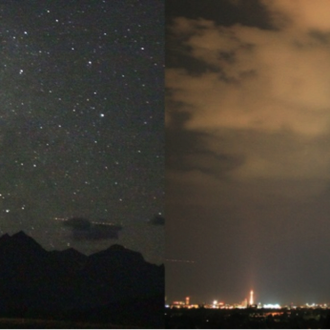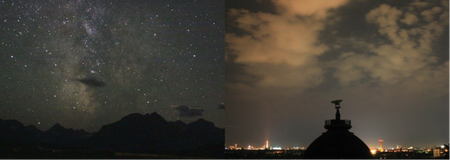The dark side of light

Light and Dark: Clouds above the Glacier National Park in Montana (USA) appear only as dark silhouettes in front of the natural night sky (left). Clouds above big cities like Berlin (right) reflect light from the ground and make a night appear even brighter.
Credit: Ray Stinson & Christopher KybaIn the highly interdisciplinary research project "Loss of the Night", scientists of very different institutions of the Leibniz Association investigate the increasing illumination of the night, its ecological, cultural and socioeconomic effects, and the effects on human health. Their aim is to develop improved lighting concepts and sustainable technologies.
Concerning astronomy, observations of celestial targets like stars and galaxies are hampered by additional light, be it from a natural source or from artificial lightning.
"Professional astronomy has long retreated to observatories at the most remote places on Earth" Axel Schwope of the Leibniz Institute for Astrophysics Potsdam (AIP) says, "Most people living in a city have never observed the Milky Way with their own eyes - or if so, they have only been able to experience this sight during travels but not at their own doorstep."
A new study that originated at the Leibniz Institute of Freshwater Ecology and Inland Fisheries (IGB) has now been published by the physicist Christopher Kyba. Using data from several measuring stations he could further quantify the effects of artificial lightning on the night sky.
The German Astronomical Society has recently established a new commission on "Light Pollution" to foster a greater awareness of this topic. The International Astronomical Union has announced to place a focus on the topics of energy efficiency and light pollution during the currently ongoing International Year of Light 2015.
Publication: Kyba C.C.M. et al. (2015): Worldwide variations in artificial skyglow. Scientific Reports 5: 8409.
More information/links:
- IGB press release
- IAU activities around the International Year of Light 2015
- German Activities during the International Year of Light
Science contact: Dr. Axel Schwope, aschwope@aip.de, +49 331-7499 232
Media contact: Kerstin Mork, presse@aip.de, +49 331-7499 469
Images
Light and Dark: Clouds above the Glacier National Park in Montana (USA) appear only as dark silhouettes in front of the natural night sky (left). Clouds above big cities like Berlin (right) reflect light from the ground and make a night appear even brighter.



